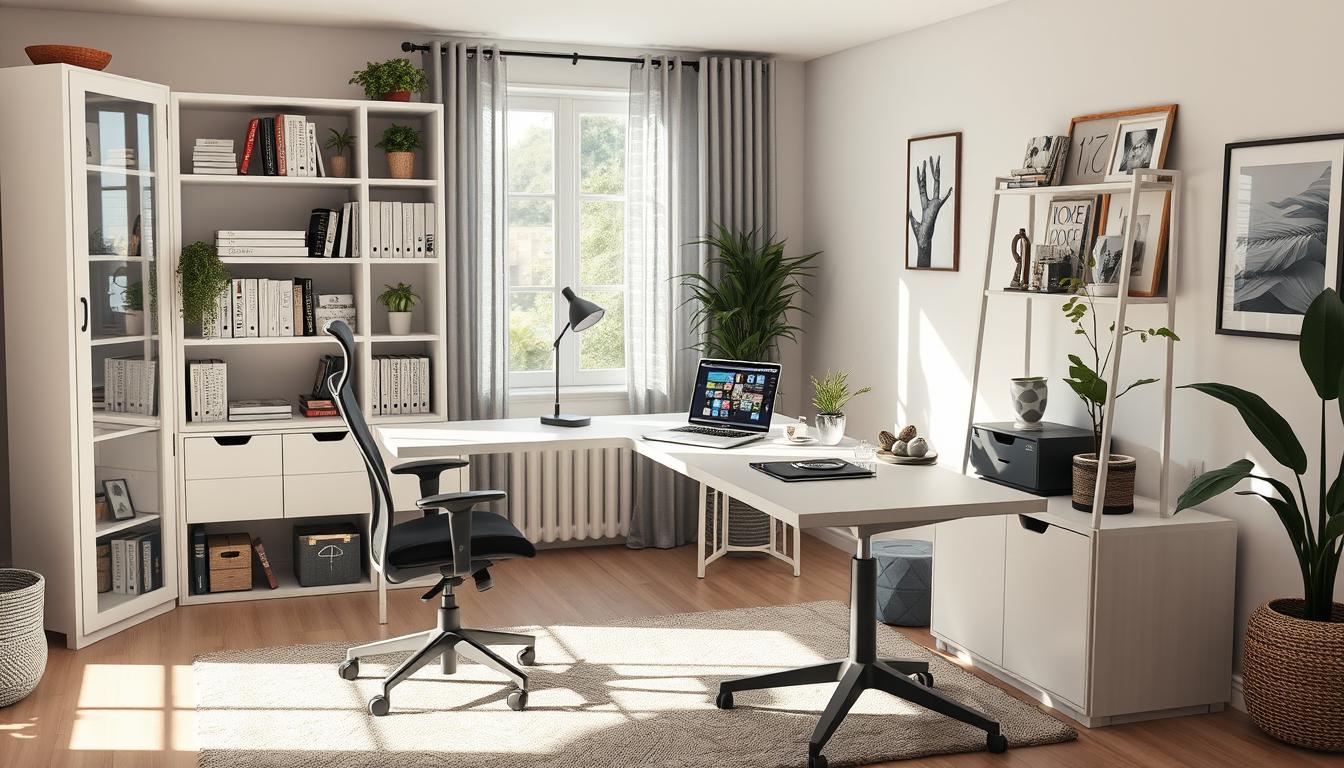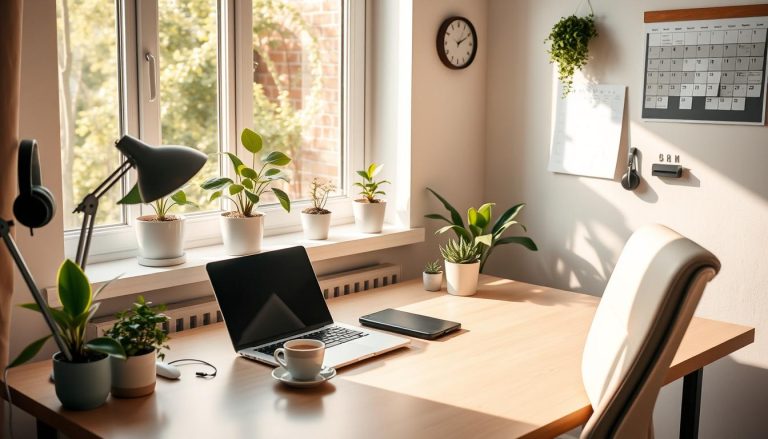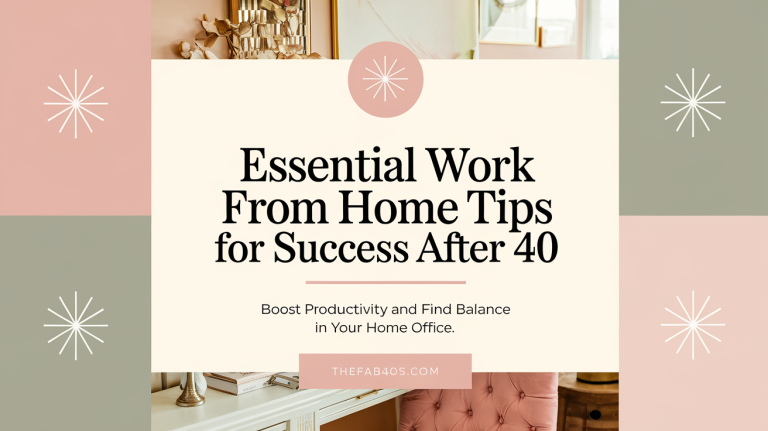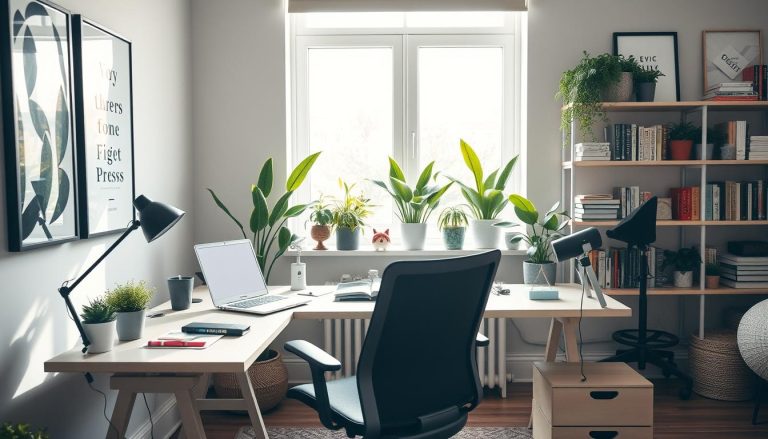Optimize Your Home Office for Productivity
Remote work has changed a lot, and how we set up our home offices matters a lot. More than 55% of workers now prefer a mix of working from home and the office. It’s clear that making our home offices work well is essential.
As 80% of leaders think remote work will stick around after the pandemic, setting up a good workspace is more important than ever. This article will share productivity tips to make your work better. We’ll look at ergonomics, lighting, tech, and keeping things organized.
We’ll see how small changes can make a big difference. Simple tweaks can help you focus better and work more efficiently.
Studies show that using the right lighting can make you 20% more productive. And having an organized space can save you up to 60 minutes a day. So, with a few changes, your home office can become a place of productivity.
The Importance of a Productive Home Office
Having a productive home office is key in today’s work world. It helps professionals stay focused and productive. Studies show that 77% of remote workers are more productive at home.
Creating a dedicated workspace is important. It helps keep work and personal life separate. This is vital for a good work-life balance.
Remote work is popular, with 52% of people working from home at least once a week. This flexibility lets people work in a place they like. By setting up a dedicated space, I can make my work area better for getting things done.
Many people prefer working from home. About 55% of employees work more hours from home than in the office. This shows how important a productive home office is for getting things done without distractions.
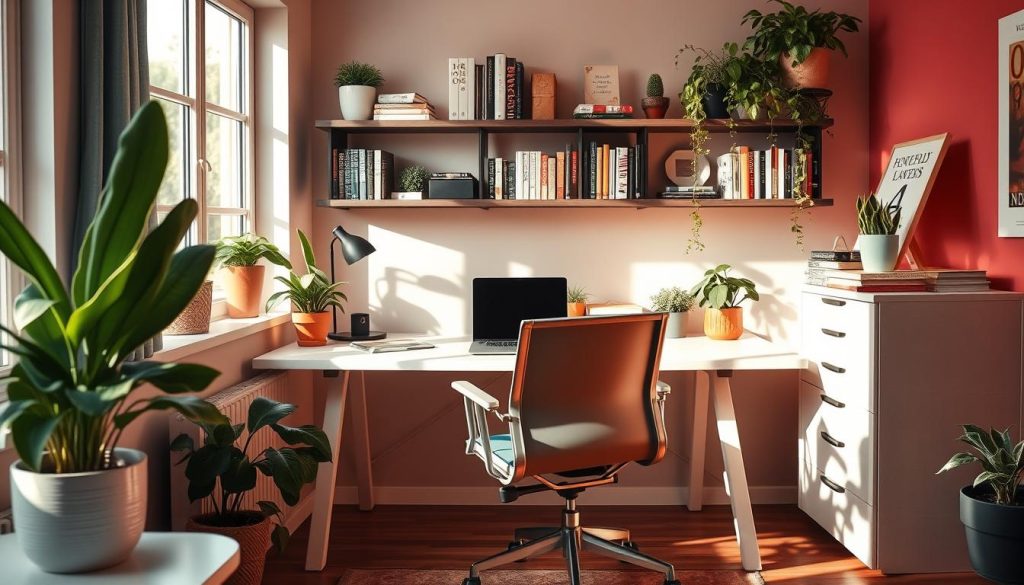
Choosing Your Home Office Location
Finding the perfect spot for your home office is key to staying focused. I’ve found that a quiet area away from daily distractions helps a lot. You can set up your office in a spare bedroom, a corner of the living room, or even a hidden closet.
When picking a spot, think about privacy and noise. A room with natural light makes your space feel welcoming. Make sure the area is big enough for you and any clients who might come by.
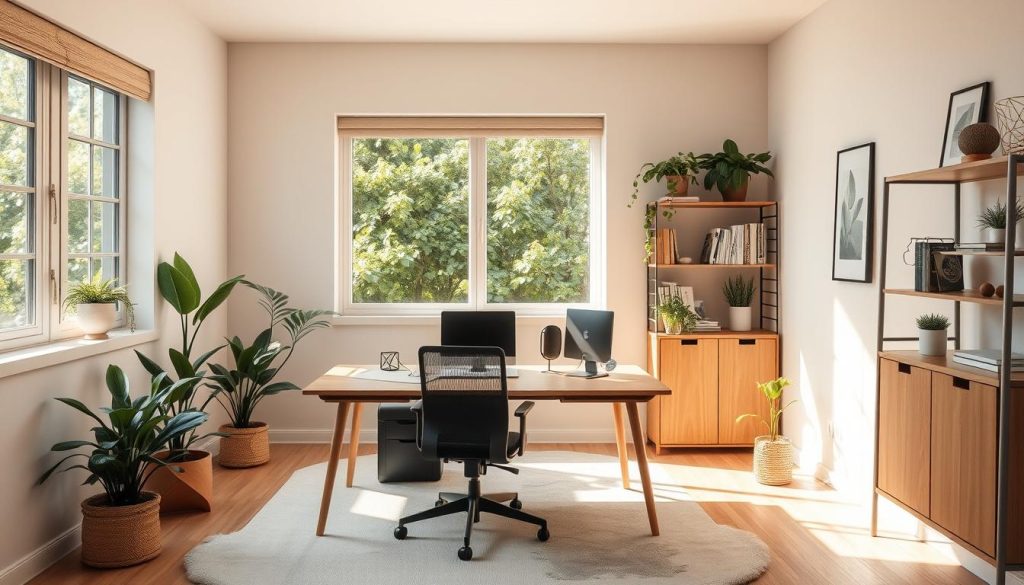
Setting up your furniture right is important for comfort and productivity. A desk that’s 28”-30” high is best for good posture. An adjustable chair is also crucial for long workdays. Plus, placing your desk near a window can make your space feel brighter and more lively.
A well-designed workspace can inspire you. Adding personal touches like art or colors that you love can make your office feel like home. By choosing the right spot, you create a space that boosts your productivity and shows off your style.
Ergonomic Furniture for Comfort
Choosing the right ergonomic furniture is key to a comfy home office. It’s vital for my productivity and health during long work hours. Adjustable chairs and proper desk ergonomics help avoid discomfort and boost focus.
Benefits of an Adjustable Chair
Adjustable chairs are crucial for a healthy posture. They come with features like height adjustment, lumbar support, and customizable armrests. These features help me adjust the chair to fit my body perfectly.
The price of ergonomic office chairs varies from $135 to $1046. This range makes it easy to find a chair that’s both affordable and supportive.
- Support for good posture
- Improved productivity
- Comfort during extended use
- Customization options for personal preferences
Importance of Desk Height
Desk height is also vital for comfort. It should let my arms rest comfortably on the keyboard, avoiding shoulder and wrist strain. An ideal desk setup also keeps my feet flat, improving blood flow.
By focusing on ergonomic furniture, especially adjustable chairs and the right desk height, my home office becomes a productive space. Making smart choices helps me create a welcoming environment for work.
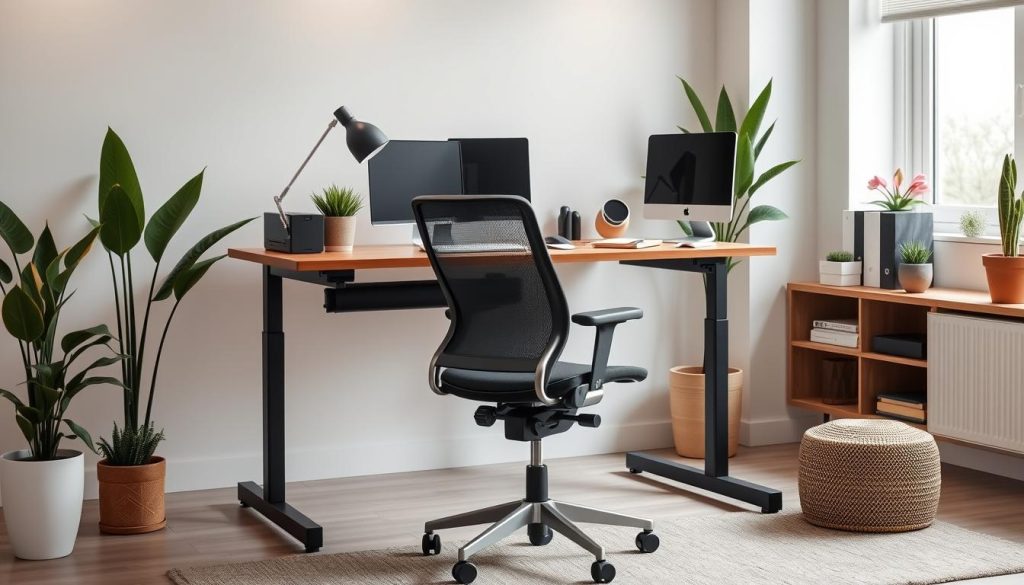
Lighting: Natural vs. Artificial
Lighting is key in a home office for productivity and mood. The mix of natural and artificial light greatly affects how we feel. Getting more natural light boosts my energy and job happiness.
Trying to get enough natural light in my office has changed everything.
Enhancing Mood with Natural Light
Natural light in my office changes the vibe. Without it, 47% of workers feel tired. Enough daylight cuts down on missing work and boosts productivity.
Natural light is much brighter than artificial, with up to 10,000 lux on sunny days. Making sure half my office gets 300 lux of daylight lifts my mood and sparks creativity.
Using Circadian Lighting for Better Focus
Circadian lighting, which follows the sun’s rhythm, has improved my focus and well-being. It adjusts throughout the day to match our natural cycles. A bright room with a nice view can make me 6% more productive.
Studies also show natural light helps me sleep better, making daily tasks easier. Mixing natural and artificial light can greatly improve my mood and work efficiency.
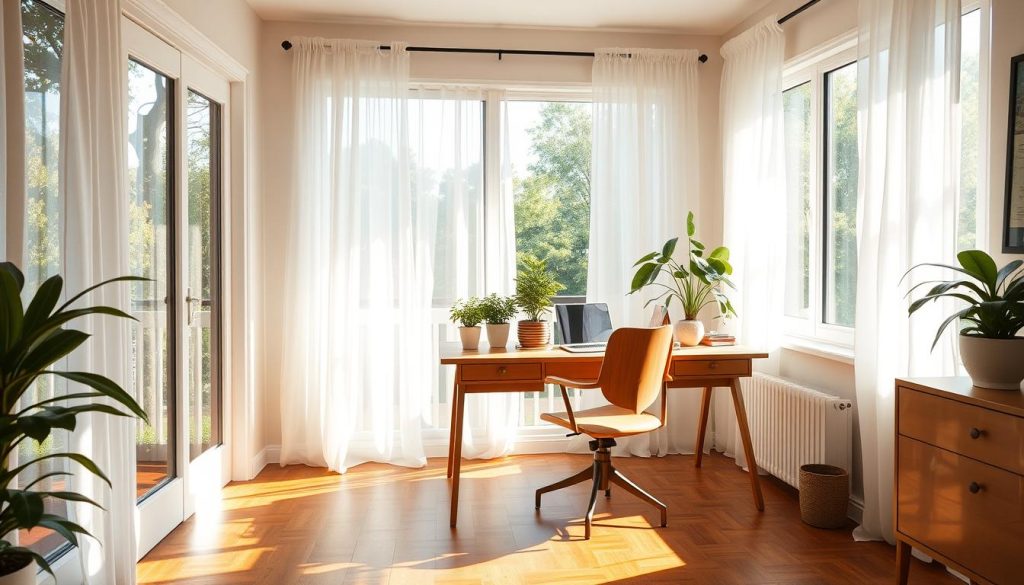
Upgrading Your Tech for Efficiency
In today’s fast-paced work environment, effective tech upgrades can significantly enhance productivity. Making the right investments in technology ensures a smoother workflow and a more comfortable workspace. Two essential components that can help boost my office efficiency are quality headphones and external monitors.
Investing in Quality Headphones
Quality headphones play a vital role in creating a focused work atmosphere. Noise-cancelling headphones with active noise cancellation technology can help drown out distractions. Brands like Bose and JBL offer excellent options that elevate the audio experience during meetings and while listening to music.
A study from the University of Miami’s music therapy department showed that subjects who listened to music while working completed tasks with superior quality and speed.
External Monitors and Their Benefits
Adding external monitors provides ample screen space that facilitates multitasking and enhances productivity. A larger monitor allows for better organization of applications and documents, reducing the time spent switching between windows. Investing in an electric standing desk alongside an external monitor can improve posture and reduce strain.
This can be particularly beneficial when combined with ergonomic accessories like proper mice and keyboards.
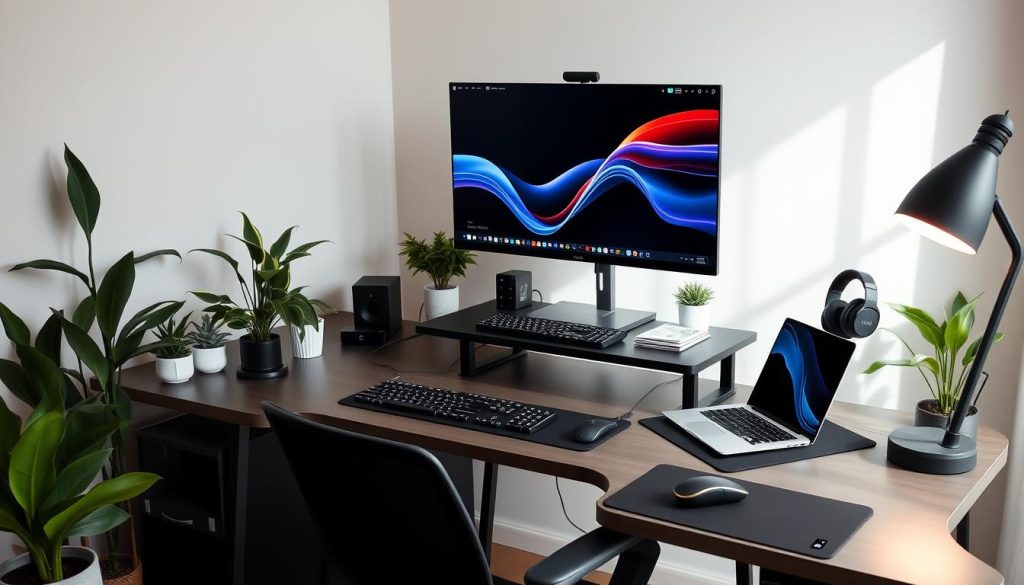
Creating a Distinct Workspace
Having a dedicated workspace at home is key for keeping work and personal life separate. It’s important to design a space that boosts productivity. The right spot, like a spare room or part of the living room, makes a big difference.
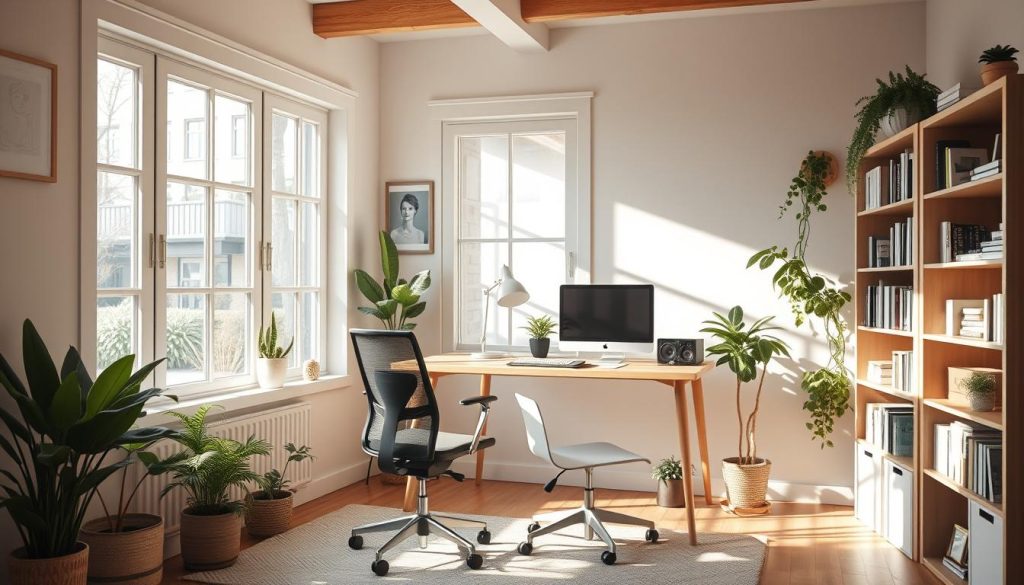
Privacy is crucial for tasks that need calls or deep focus. I add plants or art to make my space welcoming. Adjustable lighting helps avoid eye strain and keeps me in a good mood.
Keeping things tidy is vital for a productive workspace. I clean up each day to stay organized. A good chair or pillows and blankets are important for comfort. A standing desk also helps avoid aches and adds variety.
Separating work and personal life boosts productivity and improves relationships. Even with little space, setting up work zones helps stay focused. Having supplies nearby makes the space even more productive.
Decluttering Your Home Office Setup
A clean workspace boosts productivity and lowers stress. Back in the mid-90s, my cluttered home office made it hard to focus. I found organization tips to make it a space for creativity and calm. Here are some tips for decluttering your home office.
Tips for an Organized Workspace
Decluttering means sorting out what you need and letting go of the rest. Start small, focusing on one area at a time. Here are steps that helped me:
- Set clear goals for your workspace.
- Take before and after photos to see your progress.
- Get rid of trash right away to make decisions easier.
- Group similar items to see what you really need.
- Organize items in a way that fits your workflow.
Focus on quick wins to build momentum. Clearing a few papers on my desk made me feel accomplished. Small steps lead to big achievements. It’s about making progress, not aiming for perfection.
Storage Solutions to Maximize Space
Good workspace storage helps with decluttering. Use baskets, shelves, and drawer organizers for a tidy space. Think about these:
- Find out what clutters your space, like too much paper and books.
- Choose furniture that does more than one thing to save space.
- Use storage that makes it easy to find what you need.
Decluttering is about removing what doesn’t belong. By following these steps, you can make your workspace more peaceful and productive.
Setting a Routine for Productivity
Creating a consistent work routine is key, especially with more people working from home. About 67% of us now work remotely. A daily plan helps manage time and stay focused.
The Pomodoro Technique is a great way to boost productivity. It involves working for 25 minutes, then taking a break. After four cycles, you get a longer break. This method balances work and rest.
Decision fatigue can slow us down. Limiting choices helps. It’s important to set clear boundaries with family and colleagues. Letting them know your work hours helps avoid distractions.
Adding quick tasks to your routine is helpful. Tasks that take 30 minutes or less give a sense of accomplishment. About 85% of remote workers agree on the importance of a regular schedule.
Starting your day with important tasks sets a good tone. Many people, about 70%, take a coffee break around 10 AM. This refreshes their focus. Planning the next day’s tasks before ending your workday is also beneficial for 85% of remote workers.
Decorating Your Home Office
Creating a personalized environment in my home office boosts my productivity and motivation. Home office decor reflects my personality and energizes me all day. By using vibrant colors and personal touches, I turn my office into a welcoming space.
Incorporating Personal Touches
To make the space truly mine, I add elements that match my interests. Here are some ideas:
- Artwork and personal images inspire me. Displaying them on shelves or walls adds vibrancy.
- Plants beautify the space, purify the air, and calm me. They’re a great addition.
- Colorful area rugs add warmth and interest. They improve the room’s look.
Choosing Colors that Inspire
The colors in my office greatly affect my mood and productivity. Here’s how I pick inspiring colors:
- Warm, neutral tones create a cozy feel that reduces distractions.
- Pops of color, like vibrant wallpaper or accessories, make the space lively.
- Natural light from window films brightens the space. It boosts focus and creativity.
Using Technology to Your Advantage
In today’s world, using technology is key for good communication and teamwork. Video conferencing tools are very important. They help teams stay connected, even when they’re far apart.
The Role of Video Conferencing Tools
Platforms like Zoom, Microsoft Teams, and Google Meet are crucial for teamwork. With more people online, businesses must adapt fast. These tools make meetings productive and include everyone.
As companies use more tech, they’ll use over ten tools by 2025. This tech improves how we work and makes things more efficient. Features like screen sharing and virtual backgrounds make these tools easy to use.
But, it’s important to keep data safe. Most data breaches happen because of human mistakes. Using strong security helps protect against fraud and theft.
Managing Distractions While Working
Managing distractions is key to being productive at home. Setting clear work hours helps keep family members from interrupting. This way, everyone knows when I’m working.
Electronic distractions can mess up my work flow. So, I turn off news alerts and pop-ups. Noise-canceling headphones are great for blocking out street noise or construction sounds. A quiet space is crucial for focus.
I use the Pomodoro Technique for focused work. It involves 25 minutes of work followed by a short break. This boosts my productivity and helps me stay on track. Apps like Freedom and StayFocused also help by blocking distracting websites.
To handle visitors, I leave clear instructions for deliveries. This cuts down on interruptions. For childcare, having a plan in advance helps me stay focused. Keeping pets in a separate area during work also reduces distractions.
Having a cleaning schedule is another smart move. It keeps housework from distracting me. In summary, managing distractions well needs good strategies and clear communication to make a great work space.
Investing in Lighting Solutions
In my quest to create the perfect home office ambiance, I found that investing in quality lighting solutions plays a pivotal role in shaping my workspace. Proper lighting not only enhances productivity but also supports mental well-being, especially during those long hours spent behind a desk.
Light Therapy Lamps for Better Health
I’ve discovered that light therapy can be particularly beneficial in low-light conditions. Light therapy lamps mimic natural sunlight, providing a much-needed boost during dark months. They help mitigate symptoms of Seasonal Affective Disorder (SAD) and improve my overall mood.
Research indicates that working in well-lit environments significantly reduces eye strain, drowsiness, and headaches. A good light therapy lamp can range in price and might be a game-changer for anyone spending considerable time indoors.
Decorative Lighting Options for Ambiance
Decorative lighting complements my workspace while contributing to the home office ambiance. I often choose from three main types of lighting: ambient, accent, and task lighting. Ambient lighting provides general illumination, while accent lighting adds depth and focus to certain areas.
For task lighting, I prefer desk lamps that provide directed light for focused work. For instance, I found SKYLEO’s LED Desk Lamp priced at $25.99 on Amazon, which combines functionality with style. Miady’s LED Desk Lamp, at $23.99, is another affordable choice that enhances both atmosphere and efficiency.
For larger spaces, I consider ceiling lights, such as a pair of Vimhou ceiling lights, available at $89.99. Proper color temperature is crucial; I aim for lights that fall between 4000K and 6500K to create a vibrant yet cozy environment. Through careful consideration of lighting solutions, I realize how significant an impact it has on my productivity and mood while working from home.
Maximizing Small Spaces for Your Home Office
Setting up a home office in a small space can be fun. I use small space solutions that make my office both useful and pretty. With smart planning, I’ve learned to make the most of every inch and boost my productivity.
Choosing the right furniture is key. Multi-functional items are a big help:
- Foldable desks are handy and can be folded up when not needed.
- Floating desks look modern and save floor space.
- Adjustable standing desks let you switch between sitting and standing, keeping you comfortable and flexible.
Using vertical space is another smart move. Vertical storage keeps my office tidy and organized:
- Floating shelves above the desk hold books and supplies.
- Pegboards are great for hanging tools and small items.
- Wall-mounted cabinets offer hidden storage, keeping things neat.
Keeping things organized is key to a productive office. I use:
- Cable management to keep cords neat and hidden.
- Drawer dividers to sort small items like pens and paperclips.
- Labelled containers for easy access to supplies and add a personal touch.
Lighting is also important, especially in small areas. I place desks near windows to get natural light. I also use desk lamps and wall-mounted lights to save space.
With these tips, my small office becomes a productive and creative space. It shows that even in tight spots, you can have a great work area.
Final Thoughts on Optimizing Your Home Office
Creating an effective workspace boosts productivity and well-being. With more people working from home, designing a good workspace is crucial. By focusing on ergonomics, lighting, and decluttering, I can make my home office better.
Remember, a well-designed workspace can make you 20% more productive. That’s a big difference.
In this summary, I hope you learned how to improve your remote work setup. Choosing the right location and investing in quality tech and furniture are key. You don’t have to do everything at once. Start small and make changes that fit your needs.
The secret to a great home office is knowing what works for you. By reducing distractions, organizing, and taking breaks, you can stay focused. Use these tips to make your home office more efficient and enjoyable.

